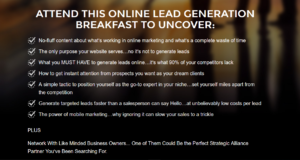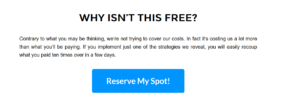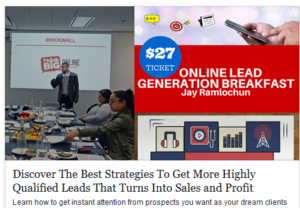2021 February
Landing Page Videos – Do they Always Work?Landing page videos. Do they work? Whether you’re on LinkedIn, Facebook or your other favourite social media, there’s no escaping videos. Of course it makes sense to use videos. With attention spans getting shorter, it’s so much easier to consume content in an audio-visual form instead of reading a long page of text.
From a content consumption point of view, people have different preferences. The auditory prefer to listen, the kinaesthetic like to read and the visual prefer images and video. Besides, video appeals to both the visual and auditory senses.
In the early days of the internet, inserting landing page videos, videos in blog post or articles was an arduous task. Nowadays it’s as simple as recording a video, making simple edits and uploading it to a blog or social media channel.
Most internet marketing gurus will tell you that you really must use landing page videos, or vidoes when creating online content.
The question is, will the strategy of using landing page videos work all the time?
To find out if landing page videos work, here’s an interesting case study.
Recently I crafted the content for a landing page promoting a business breakfast event at $27 per attendee. The target audience for the promotion was business owners who were already investing in online marketing but weren’t getting the desired return on investment.
The pain point which the landing page focused on was the dynamic state of the internet and the difficulty in keeping up with what was really working in 2016.
Headline for the landing page:
The content had all the elements of persuasive copywriting including bullet benefits, price justification and a strong call-to-action.
The following is a snapshot of the bullet points:
Price justification plug:
Traffic to the landing page was generated through paid advertising on Facebook and through a series of emails sent to the database.
Facebook ad used to drive traffic to the offer using audience insights.
The target of 15 registrations was achieved in the first 5 days of the the landing page going live.
The event itself was an eye-opener for many of the attendees, some of whom were more than willing to record video testimonials and give permission to use these to promote future events.
An encore presentation was planned the following week to meet added demand and accommodate prospects who had booked for the previous event but could not be accommodated due to capacity constraints.
This time it was decided to add the video testimonial as a proof element since it was specific to the event. Once again Facebook ads and email marketing were used to drive traffic to the landing page. Apart from the additional video testimonial, the landing page remained unchanged.
The result…
There was a marked drop in the registrations. A decision was made to split test two landing pages…one with landing page video and the other without the video.
Surprisingly the landing page without the video testimonial, converted 10 times better than the one with the landing page video.
So, does this mean that you should not use video in landing pages or sales pages?
Far from it. The lesson here is, despite what the hot shot digital marketing gurus have to say about video marketing, there’s no guarantee landing page videos will increase conversions. It could just be that your prospects get distracted by watching the video. They momentarily forget why they were on the landing page and may have left.
Rather than discard the video testimonial completely, it was put to good use in a broadcast email to the database for promoting the next event
Sub: Lead Generation Breakfast…What You Missed + Second Chance
Just thought I’d give you an update on yesterday’s Lead Generation Breakfast where Eleven Lucky Business Owners discovered exactly what’s required to generate leads online and achieve double digit growth in 2016.
The highlight of the event was the hot seat, where one lucky business owner had their online business strategy scrutinised in microscopic detail. What emerged from the hot seat were strategies and tactics which were an eye opener…worth ten times the investment made to attend the event.
Unfortunately, you weren’t able to attend. So we recorded a video to show you what one business owner thought about the event.
Click Here to Watch the Review
Now for the good news.
We’ve decided to run the event again on the 25th May 2016.
There are two reasons why we’re doing this.
A few of you registered after we had closed the bookings and expressed your disappointment.
Conflicting schedules made it impossible for some others to attend.
We totally get it…and we want to make to make it up to you.
So, we’re having an encore.
<>
Spaces are limited, so please act quickly.
<>
Best regards
(Signature)
P.S. Business owners who expressed an interest for the earlier event will be given priority, and by the time you receive this email those seats will be taken up. To book one of the remaining seats please book early to avoid disappointment. Click Here to reserve your seat.
The email had high open rates and click through to the landing page promoting the encore Lead Generation Breakfast…
…which leads to an important aspect of online marketing.
This important aspect is one which you cannot ignore even for a day if you want your business to grow. As you may have guessed it is tracking and measuring everything you do using tools such as Google Analytics.
Track the Performance of Your Website and Spy on Your Competitor’s Site
This invaluable tool will help you to track your analytics and also spy on competitor sites.
Check it out. It has a lot of other features as well, including a website malware checker.Yes. I would like to know more about this website performance measurement tool.
If you use landing page videos, make sure you split test your pages by using enticing images in one and a video in the other.
It’s the only way you will know what works for your market. As I always say, only the market can decide what they want. When you feed your market what they want, you will reap the benefits and your sales will soar.
If you would like to accelerate sales for your business using killer copywriting and marketing strategies, email contact@copywriting-results.com with details of your website and what you want to achieve. There’s no charge and is obligation-free. This offer is for serious business owners, who already invest in marketing and advertising.











